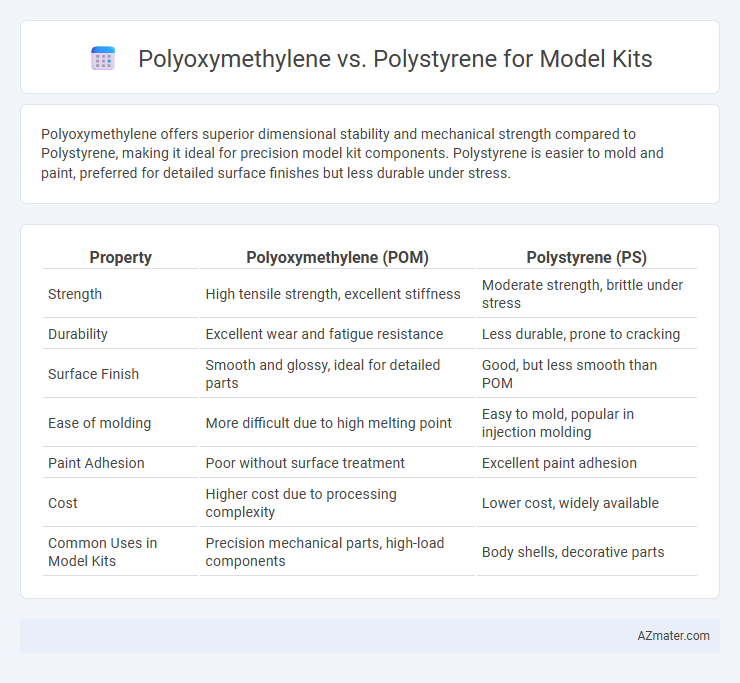Polyoxymethylene offers superior dimensional stability and mechanical strength compared to Polystyrene, making it ideal for precision model kit components. Polystyrene is easier to mold and paint, preferred for detailed surface finishes but less durable under stress.
Table of Comparison
| Property | Polyoxymethylene (POM) | Polystyrene (PS) |
|---|---|---|
| Strength | High tensile strength, excellent stiffness | Moderate strength, brittle under stress |
| Durability | Excellent wear and fatigue resistance | Less durable, prone to cracking |
| Surface Finish | Smooth and glossy, ideal for detailed parts | Good, but less smooth than POM |
| Ease of molding | More difficult due to high melting point | Easy to mold, popular in injection molding |
| Paint Adhesion | Poor without surface treatment | Excellent paint adhesion |
| Cost | Higher cost due to processing complexity | Lower cost, widely available |
| Common Uses in Model Kits | Precision mechanical parts, high-load components | Body shells, decorative parts |
Introduction to Polyoxymethylene and Polystyrene
Polyoxymethylene (POM) is a high-performance engineering thermoplastic known for its exceptional strength, stiffness, and low friction, making it ideal for precision model kit parts requiring durability and dimensional stability. Polystyrene (PS), a widely used thermoplastic in model kits, offers ease of molding, smooth surface finish, and excellent detail definition, but is less resistant to mechanical stress compared to POM. Choosing between POM and PS depends on the model's requirements for strength, precision, and ease of assembly, with POM excelling in structural components and PS preferred for intricate detailing.
Material Properties Overview
Polyoxymethylene (POM) offers high stiffness, low friction, and excellent dimensional stability, making it ideal for precise and durable model kit components. Polystyrene (PS) provides ease of molding, smooth surface finish, and good paint adhesion, preferred for detailed and visually appealing model kits. While POM excels in mechanical strength and wear resistance, Polystyrene is more cost-effective and versatile for intricate designs.
Durability and Strength Comparison
Polyoxymethylene (POM) offers superior durability and tensile strength compared to Polystyrene, making it highly resistant to wear and impact in model kit applications. Its high stiffness and low friction coefficient enhance part longevity and precision fit, whereas Polystyrene is more brittle and prone to cracking under stress. For model kits requiring robust structural components, POM provides enhanced mechanical performance, while Polystyrene is suitable for less demanding, detailed aesthetic parts.
Workability and Model Kit Assembly
Polyoxymethylene (POM) offers superior workability for model kits due to its high strength, low friction, and excellent dimensional stability, making precise assembly easier and more durable. Polystyrene (PS), common in model kits, is easier to cut, sand, and paint, but its brittleness can lead to breakage during intricate assembly stages. Choosing POM enhances long-term durability and part movement, whereas PS remains preferred for detailed surface finishing and cost-effective production.
Surface Finish and Detailing
Polyoxymethylene (POM) offers a smooth surface finish with high rigidity, which enhances fine detailing on model kits without easily deforming during assembly. Polystyrene (PS) provides a slightly rougher texture, making it easier to paint and glue but potentially less sharp in replicating intricate details. For model kits requiring precision and durability, POM excels, while PS is favored for ease of modification and surface treatment.
Paint and Adhesive Compatibility
Polyoxymethylene (POM) and Polystyrene (PS) differ significantly in paint and adhesive compatibility for model kits. Polystyrene offers excellent adhesion with most hobby glues and readily accepts a variety of paints, including acrylics and enamels, making it the preferred choice for detailed finishing. Polyoxymethylene's low surface energy makes it resistant to standard adhesives and paints, requiring specialized primers and solvent-based glues for effective bonding and painting results.
Weight and Balance in Model Kits
Polyoxymethylene (POM) offers higher density and rigidity than polystyrene, resulting in heavier yet more durable model kit components that enhance structural integrity. Polystyrene's lighter weight supports easier handling and better balance in detailed model assemblies, making it ideal for intricate parts requiring precision. Choosing between POM and polystyrene depends on the desired balance between sturdiness and ease of manipulation in the overall model kit design.
Cost and Availability
Polyoxymethylene (POM) offers superior durability and dimensional stability but comes at a higher cost compared to polystyrene, which is widely favored for model kits due to its affordability and ease of molding. Polystyrene is abundant and readily available in hobby stores, making it the preferred choice for mass-produced kits, while polyoxymethylene's limited availability and price point restrict its use to specialty models. Budget-conscious modelers typically opt for polystyrene to balance cost and accessibility without sacrificing detail quality.
Environmental Impact and Sustainability
Polyoxymethylene (POM) offers superior durability and resistance to chemical degradation compared to polystyrene, reducing the need for frequent replacement and lowering plastic waste in model kits. Polystyrene, although widely used due to its ease of molding and cost-effectiveness, poses greater environmental challenges because it is less biodegradable and more prone to fragmentation into microplastics. Choosing POM over polystyrene improves the sustainability profile of model kits by enhancing product longevity and minimizing ecological harm associated with plastic waste.
Conclusion: Which Material is Better for Model Kits?
Polyoxymethylene (POM) offers superior mechanical strength, abrasion resistance, and dimensional stability, making it ideal for precise, durable model kit components requiring fine detail and long-term resilience. Polystyrene (PS) provides excellent ease of molding, smooth surface finish, and cost-effectiveness, favored for intricate shapes and rapid prototyping but is more brittle and less resistant to stress. For model kits prioritizing durability and precision, POM is better, while PS suits applications demanding affordability and ease of use.

Infographic: Polyoxymethylene vs Polystyrene for Model Kit
 azmater.com
azmater.com